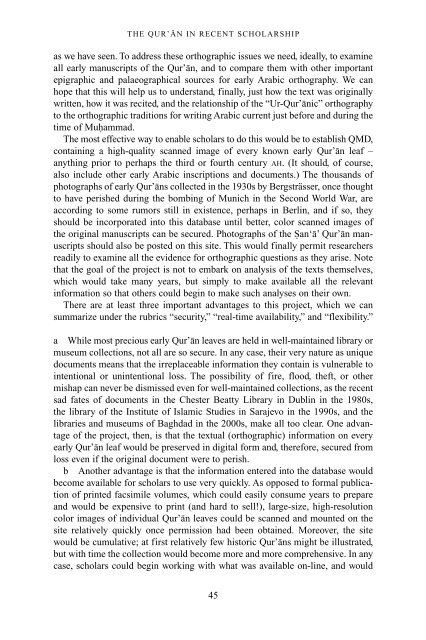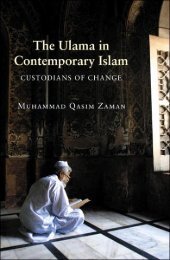The Qur'an in its historical context (pdf - Islam and Christian-Muslim ...
The Qur'an in its historical context (pdf - Islam and Christian-Muslim ...
The Qur'an in its historical context (pdf - Islam and Christian-Muslim ...
Create successful ePaper yourself
Turn your PDF publications into a flip-book with our unique Google optimized e-Paper software.
THE QUR’AN IN RECENT SCHOLARSHIP<br />
as we have seen. To address these orthographic issues we need, ideally, to exam<strong>in</strong>e<br />
all early manuscripts of the Qur’an, <strong>and</strong> to compare them with other important<br />
epigraphic <strong>and</strong> palaeographical sources for early Arabic orthography. We can<br />
hope that this will help us to underst<strong>and</strong>, f<strong>in</strong>ally, just how the text was orig<strong>in</strong>ally<br />
written, how it was recited, <strong>and</strong> the relationship of the “Ur-Qur’anic” orthography<br />
to the orthographic traditions for writ<strong>in</strong>g Arabic current just before <strong>and</strong> dur<strong>in</strong>g the<br />
time of Muhammad.<br />
<strong>The</strong> most effective way to enable scholars to do this would be to establish QMD,<br />
conta<strong>in</strong><strong>in</strong>g a high-quality scanned image of every known early Qur’an leaf –<br />
anyth<strong>in</strong>g prior to perhaps the third or fourth century AH. (It should, of course,<br />
also <strong>in</strong>clude other early Arabic <strong>in</strong>scriptions <strong>and</strong> documents.) <strong>The</strong> thous<strong>and</strong>s of<br />
photographs of early Qur’ans collected <strong>in</strong> the 1930s by Bergsträsser, once thought<br />
to have perished dur<strong>in</strong>g the bomb<strong>in</strong>g of Munich <strong>in</strong> the Second World War, are<br />
accord<strong>in</strong>g to some rumors still <strong>in</strong> existence, perhaps <strong>in</strong> Berl<strong>in</strong>, <strong>and</strong> if so, they<br />
should be <strong>in</strong>corporated <strong>in</strong>to this database until better, color scanned images of<br />
the orig<strong>in</strong>al manuscripts can be secured. Photographs of the San‘a’ Qur’an manuscripts<br />
should also be posted on this site. This would f<strong>in</strong>ally permit researchers<br />
readily to exam<strong>in</strong>e all the evidence for orthographic questions as they arise. Note<br />
that the goal of the project is not to embark on analysis of the texts themselves,<br />
which would take many years, but simply to make available all the relevant<br />
<strong>in</strong>formation so that others could beg<strong>in</strong> to make such analyses on their own.<br />
<strong>The</strong>re are at least three important advantages to this project, which we can<br />
summarize under the rubrics “security,” “real-time availability,” <strong>and</strong> “flexibility.”<br />
a While most precious early Qur’an leaves are held <strong>in</strong> well-ma<strong>in</strong>ta<strong>in</strong>ed library or<br />
museum collections, not all are so secure. In any case, their very nature as unique<br />
documents means that the irreplaceable <strong>in</strong>formation they conta<strong>in</strong> is vulnerable to<br />
<strong>in</strong>tentional or un<strong>in</strong>tentional loss. <strong>The</strong> possibility of fire, flood, theft, or other<br />
mishap can never be dismissed even for well-ma<strong>in</strong>ta<strong>in</strong>ed collections, as the recent<br />
sad fates of documents <strong>in</strong> the Chester Beatty Library <strong>in</strong> Dubl<strong>in</strong> <strong>in</strong> the 1980s,<br />
the library of the Institute of <strong>Islam</strong>ic Studies <strong>in</strong> Sarajevo <strong>in</strong> the 1990s, <strong>and</strong> the<br />
libraries <strong>and</strong> museums of Baghdad <strong>in</strong> the 2000s, make all too clear. One advantage<br />
of the project, then, is that the textual (orthographic) <strong>in</strong>formation on every<br />
early Qur’an leaf would be preserved <strong>in</strong> digital form <strong>and</strong>, therefore, secured from<br />
loss even if the orig<strong>in</strong>al document were to perish.<br />
b Another advantage is that the <strong>in</strong>formation entered <strong>in</strong>to the database would<br />
become available for scholars to use very quickly. As opposed to formal publication<br />
of pr<strong>in</strong>ted facsimile volumes, which could easily consume years to prepare<br />
<strong>and</strong> would be expensive to pr<strong>in</strong>t (<strong>and</strong> hard to sell!), large-size, high-resolution<br />
color images of <strong>in</strong>dividual Qur’an leaves could be scanned <strong>and</strong> mounted on the<br />
site relatively quickly once permission had been obta<strong>in</strong>ed. Moreover, the site<br />
would be cumulative; at first relatively few historic Qur’ans might be illustrated,<br />
but with time the collection would become more <strong>and</strong> more comprehensive. In any<br />
case, scholars could beg<strong>in</strong> work<strong>in</strong>g with what was available on-l<strong>in</strong>e, <strong>and</strong> would<br />
45



